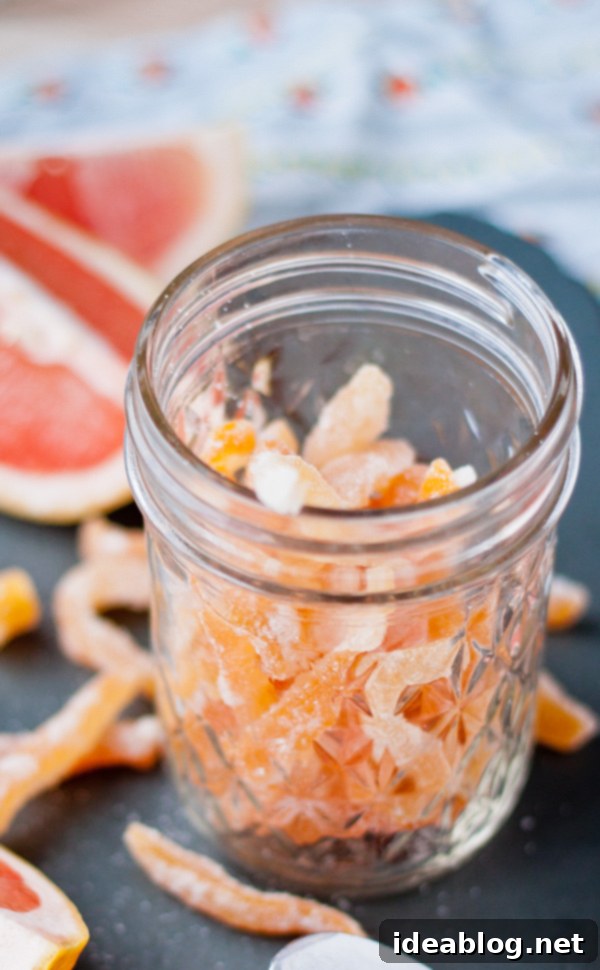Mastering Candied Grapefruit Zest: Your Guide to Sweet, Tangy Perfection
There’s an undeniable magic in the simple combination of sweet and tart, and few ingredients capture this essence quite like grapefruit. For me, it’s been a lifelong obsession. As a child, I practically subsisted on gallons of grapefruit juice, and even affectionately renamed my preschool teacher “Mrs. Grapefruit” (her real name, Mrs. Fruiterman, made the connection feel perfectly logical at the time!). Even now, I can’t imagine a better counterpoint to a stack of fluffy pancakes dripping with maple syrup. That vibrant, slightly bitter, yet incredibly refreshing flavor profile is simply captivating. If you haven’t tried this pairing, please do—it’s a revelation!

My enduring love affair with grapefruit led me to a delightful discovery years ago: candied grapefruit zest. I stumbled upon this gem in a vintage December 1991 issue of *Gourmet* magazine, and I was immediately captivated. While I’d always been a fan of various candied citrus fruits, the idea of transforming grapefruit peel into a glistening, sweet-and-sour confection was entirely new and incredibly exciting. This simple yet elegant treat promises to elevate your baking, add a gourmet touch to your desserts, or make for an unforgettable edible gift, especially during the festive holiday season.
Why Candied Grapefruit Zest is a Must-Try
Candied grapefruit zest isn’t just a pretty garnish; it’s an explosion of complex flavors and textures. Imagine a delicate strip of grapefruit peel, softened and infused with a sugary syrup, then coated in sparkling granulated sugar. Each bite offers an initial crunch, followed by a chewy, aromatic burst of sweet citrus with that signature, subtle grapefruit bitterness. It’s a sophisticated flavor that stands out from more common candied orange or lemon peels, offering a unique and memorable experience.

Beyond its incredible taste, candied grapefruit zest boasts remarkable versatility. It can be chopped finely and incorporated into baked goods like pound cakes, muffins, or cookies, lending a bright, citrusy note. It can serve as an elegant garnish for tarts, mousses, or even savory dishes. Or, perhaps most simply and satisfyingly, it can be enjoyed on its own as a delightful sweet treat, a perfect accompaniment to a cup of tea or coffee. Its vibrant color also makes it a visually appealing addition to any holiday platter or dessert spread.
The Simple Science of Candying Citrus
The process of candying citrus peel, including grapefruit, might seem intimidating, but it’s remarkably straightforward. It primarily involves two key stages: blanching and simmering in syrup. Understanding the purpose behind each step is crucial for achieving that perfect, translucent, and flavorful result.
- Blanching for Bitterness Removal: Grapefruit peel, while wonderfully aromatic, also contains natural oils and a significant amount of bitterness, especially in the white pith. The blanching process – repeatedly boiling the zest in fresh water – is essential for drawing out these bitter compounds. This step ensures that your final candied zest is pleasantly tangy and sweet, not overpoweringly bitter. Think of it as a gentle purification, preparing the peel to absorb all the delicious sugar syrup.
- Slow Simmering in Syrup: After blanching, the zest is slowly simmered in a sugar syrup. This process isn’t just about sweetening; it’s about infusing and preserving. The sugar syrup gradually replaces the water content in the zest, resulting in a tender, translucent texture. The corn syrup, a small but mighty addition, plays a vital role here. It helps prevent the sugar in the syrup from crystallizing, ensuring a smooth, shiny coating on your candied peel. This slow infusion is what gives candied zest its characteristic chewiness and long shelf life.
Gathering Your Simple Ingredients
One of the most appealing aspects of this recipe is its minimal ingredient list. You don’t need exotic items; just a few pantry staples are enough to create this gourmet delight:
- Fresh Grapefruit: Opt for large, firm grapefruits with thick, unblemished skins. The thicker the peel, the easier it will be to work with and the more substantial your candied strips will be.
- Granulated Sugar: This forms the basis of your syrup and provides the sweet coating.
- Cold Water: Used for blanching and creating the sugar syrup.
- Light Corn Syrup: As mentioned, this is a secret weapon to prevent sugar crystallization and impart a beautiful shine to your finished product. Don’t skip it if you want that professional candied look and texture.

A Journey of Patience: The Step-by-Step Process
While the steps are simple, candying grapefruit zest is a process that rewards patience and a little bit of attention. It’s not a “five-minute throw-together” recipe, but the hands-on time is incredibly rewarding.
1. Preparing the Grapefruit Peel: The Art of Pith Removal
Begin by slicing your grapefruits into four equal segments, from navel to navel. Then, carefully remove the juicy fruit, leaving you with just the thick peel. This is where the “arm workout” might come in! Using a sharp paring knife and a spoon, diligently scrape away as much of the white pith from the inside of the peel as possible. The pith is the primary source of bitterness, so thorough removal is key. Avoid using a vegetable peeler for this initial step, as you want the peel to be thick and sturdy enough to handle the subsequent cooking without becoming flimsy.
Once the pith is mostly removed, slice the zest into ¼-inch thick strips. Uniformity is nice, but don’t stress if some pieces are a bit longer or shorter; they’ll still taste amazing.
2. The Essential Blanching Process
This is arguably the most critical step for delicious candied zest. Place your prepared zest strips in a large saucepan and cover them with at least 4 cups of cold water. Bring this to a boil and simmer for 10 minutes. After 10 minutes, drain the zest through a fine-meshed sieve and rinse it thoroughly under cold running water. This entire boiling, draining, and rinsing process needs to be repeated two more times. Yes, three times in total! This repetitive blanching is what effectively leaches out the bitter oils and ensures a wonderfully balanced flavor in the finished product.
3. Crafting the Sugar Syrup
While your zest is blanching, prepare your drying station. Lay out two half-sheet pans and generously sprinkle each with 1 cup (200g) of granulated sugar. This sugar will be used to coat the candied zest later. Next, in your now-empty saucepan, combine the remaining 2 cups (400g) of granulated sugar with 1 cup (240mL) of water and add the 3 tablespoons of light corn syrup. Bring this mixture to a boil and let it simmer for 3 to 4 minutes, ensuring the sugar fully dissolves and the syrup begins to thicken slightly.
4. The Candying Transformation
Add your blanched and drained grapefruit zest strips to the simmering sugar syrup. Continue to cook this mixture over medium-low heat, stirring frequently. The goal here is to allow the zest to slowly absorb the sugar and become translucent. This process usually takes about 30-45 minutes. You’ll want to use a candy thermometer to monitor the syrup’s temperature; it should reach 230°F (110°C), which is the soft-ball stage. At this point, the zest should appear shiny and significantly more translucent, almost resembling gummy bears.
5. Coating and Drying for Perfection
Once the zest has reached the desired translucency and the syrup is at temperature, carefully transfer the hot zest strips from the syrup to your sugar-dusted sheet pans using a fork, allowing as much excess syrup as possible to drip off. Spread the pieces out evenly and then gently toss them with the granulated sugar to coat them thoroughly. Separate any strips that stick together. Allow these sugar-coated strips to cool completely on the pans.
For the final drying stage, transfer the coated zest to a cooling rack. Place a sheet of wax paper underneath the rack to catch any sugar that falls off, making cleanup easier. Allow the zest to dry overnight, or even longer depending on the humidity in your kitchen. The goal is for the zest to be firm and slightly tacky, but not wet. Once fully dry, store your candied grapefruit zest in an airtight container, layered with wax paper, for up to one month. In a very dry, cool environment, it might last even longer.

Tips for Candied Zest Success
- Choose the Right Grapefruit: Look for grapefruits with relatively thick skins, as these yield more substantial and easier-to-handle zest strips.
- Pith Removal is Paramount: Take your time scraping off the white pith. This is the single most important step to prevent overly bitter candied zest. Aggressive scraping is encouraged!
- Don’t Rush the Blanching: The three rounds of boiling and rinsing are non-negotiable for removing bitterness.
- Use a Candy Thermometer: Achieving the correct syrup temperature (230°F / 110°C) is crucial for the perfect texture and shelf life.
- Humidity Matters: If you live in a humid climate, the drying time may be extended. Ensure good air circulation around the cooling rack.
- Even Coating: Make sure each strip is well-coated in sugar after simmering. This not only adds sweetness but also helps prevent stickiness.
Creative Ways to Enjoy Your Candied Grapefruit Zest
The possibilities for using your homemade candied grapefruit zest are endless! Here are a few ideas to get you started:
- Elevate Baked Goods: Chop it finely and fold it into scone dough, muffin batter, cookie dough, or even a classic pound cake.
- Garnish Extraordinaire: Use whole strips as a beautiful, edible garnish for frosted cakes, chocolate desserts, fruit tarts, or creamy panna cottas.
- Cocktail Companion: Drop a strip into a gin and tonic, an old fashioned, or a sparkling cocktail for a gourmet touch and a burst of citrus aroma.
- Chocolate Pairing: Dip half the candied strip in melted dark chocolate for an irresistible confection.
- Festive Snacking: Simply arrange a bowl of it for guests to enjoy as a sweet and tangy treat, especially during the holidays.
- Granola & Yogurt Boost: Chop and sprinkle over your morning yogurt, oatmeal, or homemade granola for an exciting flavor addition.
- Edible Gift: Package a batch in a pretty jar or cellophane bag for a thoughtful and delicious homemade gift during Christmas or any special occasion.
Grapefruit lovers, unite! This recipe is a celebration of this incredible citrus fruit, transforming its often-discarded peel into a jewel-like confection. The sweet, tart, and subtly bitter notes create a truly unique flavor profile that’s both comforting and exciting. While it requires a bit of time and attention, the process is therapeutic, and the reward is a batch of exquisite candied grapefruit zest that will undoubtedly impress anyone who tries it.

Candied Grapefruit Zest
Pin
Review
SaveSaved!
Ingredients
- 3 large grapefruits
- 4 cups (800 g) granulated sugar divided
- cold water
- 3 tablespoons light corn syrup
Instructions
-
Slice the grapefruit navel-to-navel into four equal segments. Using a sharp knife and spoon, remove the fruit, so that you are left with the peel only. Working with one segment at a time and using a spoon, scrape the inside of the peel repeatedly (and aggressively) to remove as much of the white pith as possible. This will help remove most of the bitterness.
-
Once you have removed the pith, slice the zest into ¼-inch thick strips. Don’t worry if you have some pieces that are longer or shorter than others. Repeat until you have trimmed all of the grapefruit segments.
-
Place the zest strips in a large saucepan and cover with 4 cups (1 quart) of cold water. Bring to a boil and simmer for 10 minutes. Drain the zest in a fine-meshed sieve, and run until cold water. Repeat this entire process two additional times. This helps remove the oils and natural bitterness.
-
Set out two half sheet pans and sprinkle each pan with 1 cup (200 g) of granulated sugar. Set aside. Combine the remaining 2 cups (400 g) granulated ugar and 1 cup (240 mL) water in the saucepan and add the corn syrup. Boil the mixture for 3 to 4 minutes.
-
Continue to simmer the syrup, add the zest, and cook, stirring frequently, until a candy thermometer reaches 230°F (110°C). At this point, the zest should look fairly translucent and shiny, similar to a gummy bear in appearance.
-
Transfer the zest to the sugar-dusted pans with a fork, draining as much of the syrup as possible, and spread the pieces out. Toss the zest with the sugar to coat well, separating the strips. Allow them to cool completely.
-
Transfer zest to cooling rack, place a sheet of wax underneath to catch any sugar mess, and allow the zest to dry overnight. This may take slightly longer, depending on the humidity of your kitchen. Store candied zest in a covered container, place in layers separated by wax paper, for up to 1 month.
